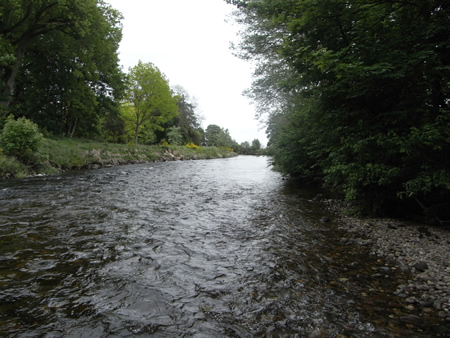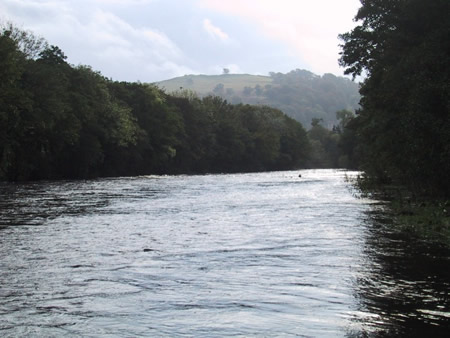These bulletin blogs represent news about Finavon and the South Esk, and my views as a riparian owner. They are not the views of any other organisation, nor are they designed to promote the interests of any individual or organisation other than Finavon Castle Water and factors affecting the fishery. Tony Andrews
I have never seen the South Esk hold high levels of water so consistently and for such a long period in mid summer, as has happened in June and early July this year.
As I write this bulletin in the morning of Sunday 8/7, the river is fining down to a good height for night sea trout fishing, but it is likely that most of the sea trout have already taken the opportunity of good flows to migrate into the upper river and the high ground tributaries. As evidence for that bit of speculation, I note that Cortachy and Downie Park have started to catch more sea trout. Nevertheless, so far this season we have already caught 74 sea trout in FCW pools, with three over 5lbs. My impression of the 2012 sea trout numbers is that they are similar to recent years. However, the quality of individual sea trout is excellent, which tells us something about the nutritious value of prey they are finding along the coast.
I mentioned in a previous blog that my ecologist friend, Jens Christian Holst, who works at the Institute of Marine Research in Bergen, Norway, predicted that in 2012 there would be some very large MSW salmon returning to the rivers of southern Norway and the east coast of Scotland and England. There is ample evidence that his prediction is correct, with examples of an estimated 48lbs salmon from the Balmoral water, and good fish of up to 25lbs from both Esks. In fact there have been reports of big salmon from many rivers, from the Tyne to the Naver and all rivers between. Unfortunately Jens Christian also predicted yet another poor grilse run. Like all matters concerning wild creatures nothing is ever black and white, so there will be some grilse that have found good feeding in the NE Atlantic, but on the whole we can expect undernourished ‘thin’ grilse, and not that many of them. I would be pleased if his prediction concerning grilse was wrong! In the coming years, as the implications of the SALSEA project work through the system, there is likely to be better predicting of returning migrations of wild Atlantic salmon, in terms of both numbers and quality. The implications of these predictions should enable fishery managers to take informed decisions to conserve fragile populations, instead of the guesswork and delayed actions they depend on at present.
The photo above was taken looking downstream from the head of Marcus House Pool. The left bank is owned by Marcus Estate but is not fished by Marcus rods because of an agreement whereby FCW anglers do not fish the pool below, Breadalbane, in return for exclusive use of House Pool by Finavon rods. Marcus Estate is now on the market and the new owner may decide to retain the current agreement, or revert to the previous free-for-all, where Marcus rods virtually stood on top of the fish while fishing from the rocky north bank of House Pool, and Finavon rods waded through the best lies at the head of Breadalbane Pool.
At Finavon we have caught and released a good number of MSW salmon up to 19lbs. On Friday Alec Towns, who knows Finavon well and is an experienced and skilled fisherman, hooked a very large salmon in Beeches Pool (just above the Aqueduct on Castle Beat). When this great fish took his fly it nearly wrenched the rod out of his hands. He played the fish for half an hour or so, with strong runs down into Haughs Pool below the aqueduct, and, after coaxing it back into the quiet glide immediately upstream of the aqueduct, started to feel that the fish was tiring. By this time he had seen the fish many times at close range. It was fresh from the sea and, judging by the size of its tail and its breadth & length, was almost certainly more than 25lbs. The last moments of contact with this beautiful salmon were spent applying side strain to inch the fish back across the river (no more than 20 yards wide at that point) towards where he was standing about ten yards upstream of the aqueduct. Suddenly there was a loud “crack” as his brand new top brand rod shattered with its second section above the butt broken into two pieces. The shock of the sudden break put huge strain on the 12lbs cast and broke it at the fly. When I saw Alec afterwards he was sad and disappointed because, as he said “it was the fish of a lifetime” lost as a result of an unreliable rod. I sometimes (increasingly often!) toy with the notion of returning to the past to fish with my Sharpes impregnated, spliced cane rods!
Other large salmon have been seen. One, described by Moray as “a dolphin” showed tantalisingly in the smooth glide immediately upstream of Volcano on Milton Beat, was a very large salmon (estimated at well over 20lbs), and other fish of a similar size have been reported from Frank’s Stream and Indies Pool on Indies Beat. As I have fished in the last few days I have been aware of the possibility of catching a really big salmon. They are there, but not in big numbers. Our regular visitor and designer of the FCW website, Simon Walter, who only started salmon fishing three years ago, caught three salmon to 15lbs at Finavon, and a very pretty 8lbs fish at Stracathro on the North Esk, plus two sea trout for his week. He drove South last night, a contented and relaxed man!
In my next blog I shall report on an inspiring visit to the Rottal Burn.
TA on 8/7/2012


